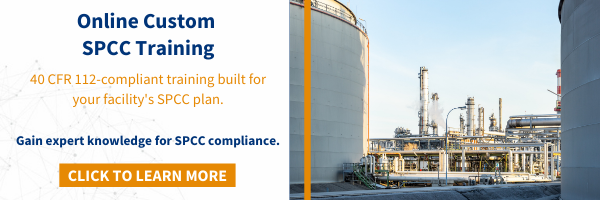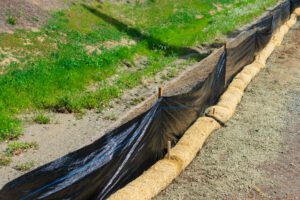Is your facility required to maintain and implement a Spill Prevention, Control and Countermeasure (SPCC) plan in accordance with the SPCC rule (40 CFR 112)?If so, you have probably looked into one of the key requirements for oil storage containers, piping, transfer areas, and equipment in the SPCC rule: the SPCC secondary containment requirements (40 CFR 112.7(c)).
Secondary containment is one of the key requirements for SPCC compliance. A comprehensive discussion on this requirement is provided in the United States Environmental Protection Agency’s (EPA) SPCC Guidance for Regional Inspectors (EPA 550-B-13-002, 12/16/2013). This resource is highly valuable to keep on hand. Here we’ll outline some of the most important aspects of secondary containment requirements so you can maintain compliance at your facility.
What is Secondary Containment and Why Is It Needed?
One of the primary ways the SPCC rule aims to prevent oil discharges is by requiring secondary containment.
Secondary containment provides temporary containment of discharged oil until response and cleanup can occur. Costly environmental cleanup and reportable discharges can possibly be avoided when secondary containment is implemented appropriately.
What Types of Secondary Containment Are Discussed in the SPCC Rule?
The SPCC rule discusses two categories of secondary containment: General and Specific (Sized).
General Secondary Containment
General secondary containment addresses all regulated parts of a facility and includes areas, containers, and equipment. Mobile refuelers, oil-filled equipment, transfer areas, and piping are included. The method, design, and capacity for general secondary containment only needs to consider the typical failure mode.
Specific (Sized) Secondary Containment
Specific (sized) secondary containment addresses specific parts of the facility. This typically includes bulk storage containers (such as aboveground storage tanks), and mobile and portable containers (such as drums and totes). These specific provisions provide explicit requirements for sizing, design, and freeboard based on precipitation.
Secondary Containment Examples
General and specific (sized) secondary containment come in many varieties, both active and passive. Below are some examples of secondary containment in each category along with their application.
General Secondary Containment Examples
- Retention ponds capture site-wide stormwater before flow enters a waterway offsite.
- Sorbent materials/booms are actively deployed when there is a spill.
- Oil water separators recover oil from spill diversion systems or areas where oil is part of the process. These are sized for the most likely oil discharge.
Specific (Sized) Secondary Containment Examples
- Double walled tanks can be used for aboveground storage tanks.
- Diking or curbing with impervious concrete floor and walls may be used with drum and tote storage areas, single walled aboveground storage tanks, and transfer areas.
- Blind sumps/trenching can be used in storage and transfer areas.
- Spill pallets can be used with drum or tote storage.
- Oil water separators are sized to contain largest container and handle flow from any precipitation in its drainage area.
Understanding when each category can be applied and chosen for compliance with the SPCC rule can be complicated. Your facility set up, storage, equipment, and operations will all be a part of the equation. A thorough review should be completed by each facility, keeping good engineering practices in mind and a consultant or professional engineer at hand.
More About Specific (Sized) Secondary Containment Design and Freeboard
Under the specific (sized) category, several factors need to be considered for the design. Establishing how much containment is required is the starting point. General practice is to design containment to be able to handle the total volume of the largest single container.
If outdoors, “sufficient freeboard” for the precipitation will need to be incorporated into the design capacity. Freeboard in the case of specific (sized) secondary containment is the volume incorporated into the design to account for any precipitation accumulation. No standard definition for “sufficient freeboard” is provided by the US EPA, who instead defers to good engineering practice. Standard methods to calculate necessary freeboard include the use of a 25-year, 24-hour storm event, or the use of 110% of volume of the largest container.
Some states and local fire codes may also have specific requirements for secondary containment design, capacity, and freeboard for aboveground storage tanks and other containers. You will need to check the rules of your local jurisdictions to make sure you are also in compliance with those requirements.
I Have Existing Specific (Sized) Secondary Containment. Is It Enough?
If you have existing specific (sized) secondary containment and want to determine if you have enough volume, you will need to collect some information. The general process for this evaluation is as follows:
- Determine the volume of the containment area (length, width, and height or depth).
- Determine the volume of any additional sumps or other parts adding volume.
- Subtract out the volume of any objects providing displacement (tank pads, pedestals, equipment, other containers, etc.).
- The result is the volume available for containment without the precipitation freeboard.
- Calculate the precipitation freeboard volume for the containment and subtract from the available containment.
- The result will be your available containment with the precipitation freeboard.
- Is the calculated volume greater than the largest container in that containment? If so, then your existing secondary containment should be sufficient.

Do SPCC Secondary Containment Requirements Include Recordkeeping?
The SPCC rule does not require secondary containment calculations be kept in your SPCC plan. However, the SPCC plan does need to include information on how the facility is meeting the requirements for general and specific (sized) secondary containment for all regulated parts of the facility and associated storage containers and equipment. Including the basis for how you are meeting these requirements (i.e., calculations, drawings, etc.) will ensure documentation for SPCC rule compliance, and it will be available for the US EPA or other agencies if they knock on your door.
One additional recordkeeping requirement for outdoor specific (sized) secondary containment is the removal of accumulated precipitation from containment. Since precipitation will accumulate in outdoor containment (unless covered), 40 CFR 112.8(c)(3) requires that stormwater accumulations be inspected for the presence of oil and that records of the drainage events be maintained. Prior to draining these areas, accumulated oil on the rainwater must be removed and returned to storage or disposed of in accordance with legally approved methods. Also note that additional requirements may be present in any issued National Pollutant Discharge Elimination System (NPDES) stormwater discharge permits or other regulations governing your facility.
What If I Cannot Provide Secondary Containment?
There are some options available for your facility if secondary containment cannot be provided per the SPCC rule requirements. Impracticability Determinations and meeting Qualified Oil Filled Operational Equipment criteria are two options. However, thorough review and evaluation by a professional engineer with experience in the SPCC rule is recommended.
State and local fire code requirements may be inconsistent with SPCC rules, so your facility should always be evaluated to maintain compliance on multiple fronts.
Get Support Meeting SPCC Secondary Containment Requirements
The SPCC rule can be complicated, even more so if state or fire code requirements come into play. Evaluating and documenting your compliance with the secondary containment provisions and determining your needs can be overwhelming, However, noncompliance can lead to financial penalties and puts the environment and your community at risk.
For help with this task and meeting other requirements of the SPCC rule, contact Tetra Tech’s experts today at [email protected]. We can help you interpret your facility’s specific regulatory requirements and develop a strategy to maintain compliance.






